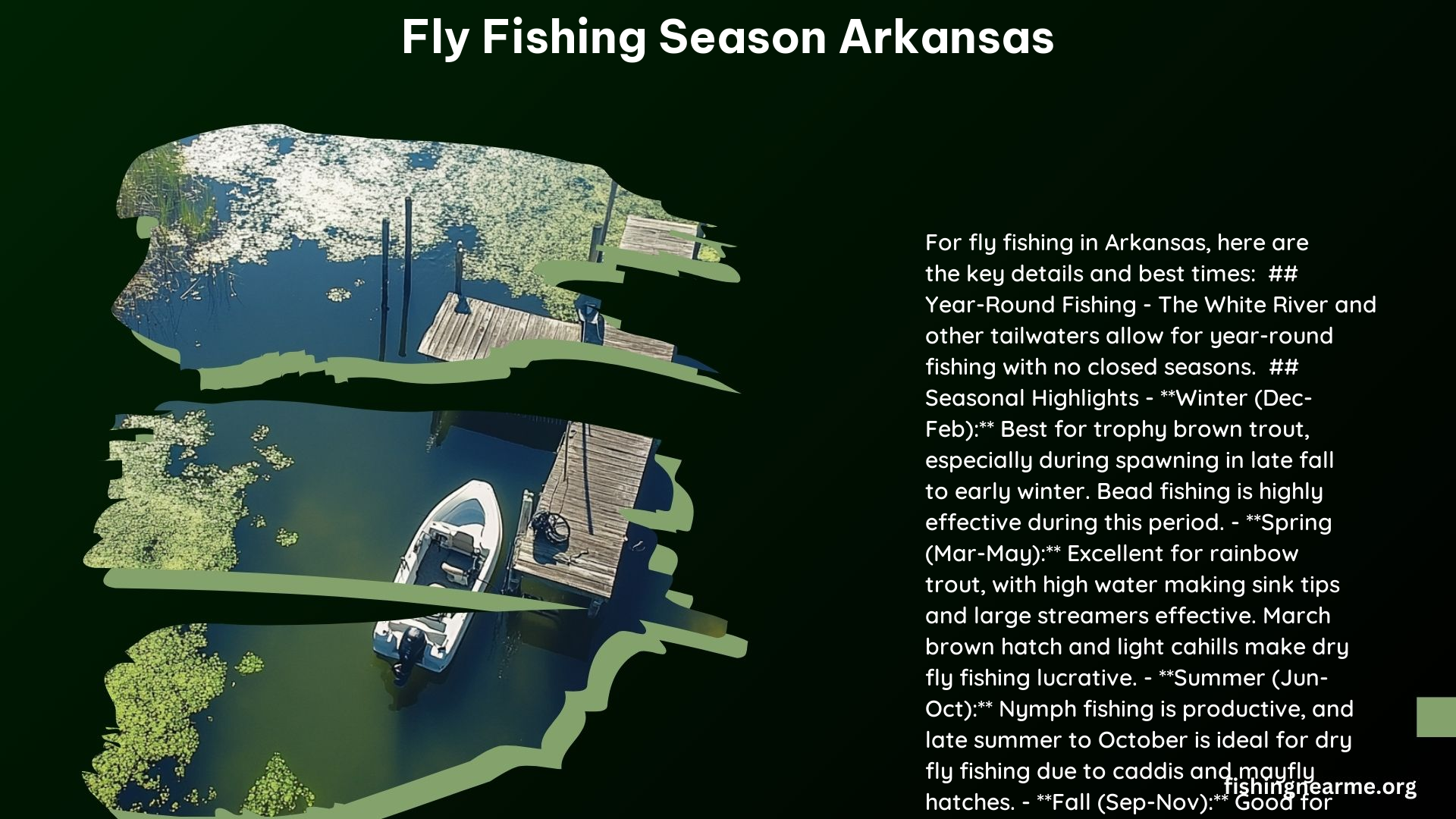Arkansas offers year-round fly fishing opportunities, with peak seasons in spring and fall. The state’s diverse waterways, from the renowned White River to hidden Ozark streams, provide excellent habitats for trout, bass, and other species. This guide covers regulations, prime locations, seasonal patterns, and essential tips for fly fishing in Arkansas.
What Are the Key Regulations for Fly Fishing in Arkansas?
License Requirements
- All anglers 16 and older must possess a valid Arkansas fishing license
- Trout fishing requires an additional trout permit in designated waters
- Licenses available online or from authorized retailers
Catch Limits
| Species | Daily Limit | Size Restrictions |
|---|---|---|
| Trout | 5 | Only 1 over 16 inches in some areas |
| Smallmouth Bass | Varies by zone | 14 inches minimum in Ozark Zone |
| Largemouth Bass | Varies by water | 15 inches minimum in some lakes |
Restricted Areas
- White River below Bull Shoals Dam: Special regulations apply
- Little Missouri River: Catch and release for brown trout in certain sections
- Some streams in national forests may have specific rules
Where Are the Best Fly Fishing Spots in Arkansas?
White River
- Known for world-class trout fishing
- Access points: Multiple public ramps and private resorts
- Best times: Spring and fall for hatches, year-round for tailwater fishing
- Target species: Rainbow, brown, and cutthroat trout
Little Red River
- Famous for its trophy brown trout
- Access: JFK Park, Lobo Landing, Barnett Access
- Peak seasons: Spring for hatches, fall for spawning runs
- Fly patterns: Midges, sowbugs, and streamers
Norfork River
- Excellent for wade fishing
- Access: Dam tailwater and several public access points
- Best times: Spring and fall for hatches
- Target species: Rainbow and brown trout
Buffalo National River
- Scenic fishing for smallmouth bass
- Access: Multiple points along the 135-mile river
- Peak season: Late spring through early fall
- Fly patterns: Poppers, streamers, and terrestrials
What Are the Seasonal Patterns for Fly Fishing in Arkansas?
Spring (March – May)
- Prime time for mayfly and caddis hatches
- Water levels can be high due to spring rains
- Best for dry fly fishing on most rivers
Summer (June – August)
- Early mornings and evenings best for fishing
- Focus on tailwaters for cooler temperatures
- Terrestrial patterns become effective
Fall (September – November)
- Excellent for brown trout spawning runs
- Cooler temperatures improve fishing conditions
- Blue-winged olive hatches common
Winter (December – February)
- Tailwaters offer consistent fishing opportunities
- Midges and small nymphs are effective
- Potential for trophy trout in less crowded conditions
What Fly Patterns Are Most Effective in Arkansas?
Dry Flies
- Adams (sizes 14-18)
- Elk Hair Caddis (sizes 14-18)
- Blue-Winged Olive (sizes 18-22)
Nymphs
- Pheasant Tail (sizes 14-18)
- Hare’s Ear (sizes 14-18)
- Sowbug (sizes 16-20)
Streamers
- Woolly Bugger (sizes 6-10)
- Sculpzilla (sizes 4-8)
- Clouser Minnow (sizes 6-10)
How Can I Prepare for a Fly Fishing Trip to Arkansas?
Essential Gear
- 4-6 weight fly rod for trout, 6-8 weight for bass
- Floating and sinking tip lines
- Waders and wading boots
- Polarized sunglasses
- Assortment of flies based on season and target species
Local Regulations
- Check current fishing regulations before your trip
- Be aware of any special regulations for specific waters
- Obtain necessary licenses and permits
Guided Trips
- Consider hiring a local guide for unfamiliar waters
- Many fly shops offer guide services and local knowledge
- Book in advance, especially during peak seasons
What Are Some Tips for Successful Fly Fishing in Arkansas?
- Match the hatch by observing local insect activity
- Practice catch and release to preserve fish populations
- Use barbless hooks for easier release and less fish damage
- Check water release schedules for tailwaters before fishing
- Respect private property and use designated access points
- Be prepared for sudden weather changes, especially in mountain areas
By following these guidelines and exploring the diverse fly fishing opportunities in Arkansas, anglers can enjoy successful and memorable experiences throughout the year. Remember to always practice responsible fishing and respect the natural environment.
References:
1. Arkansas Game and Fish Commission
2. Arkansas State Parks Fishing Guide
3. Fly Fisherman – Arkansas Fishing

